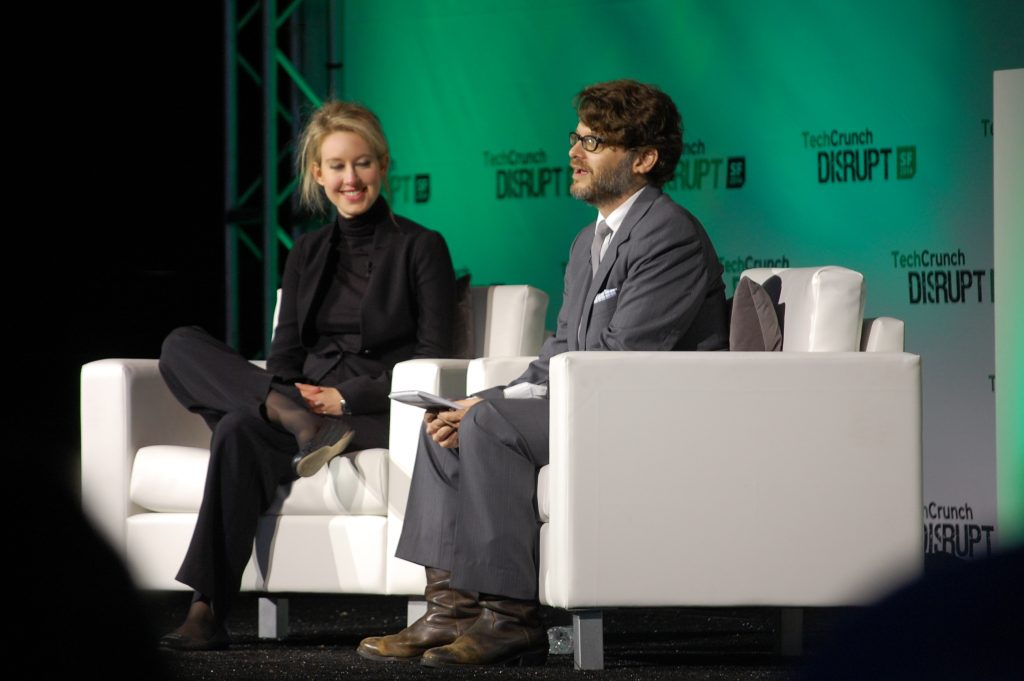Featured image: “Fortune Global Forum 2015” by FORTUNE Global Forum is licensed under CC BY-NC-ND 2.0.
Theranos founder and CEO ‘Elizabeth Holmes’ proves that manners indeed maketh man! Well, at least in the business industry.

“Elizabeth Holmes of Theranos” by Kevin Krejci is licensed under CC BY 2.0.
Dressed in an iconic all-black outfit featuring the black turtleneck and black trousers as her staple, Elizabeth Holmes pairs this with her renowned deep voice to make waves as the next Steve Jobs. Theranos, a blood-testing startup that promised a breakthrough in healthcare technology, was founded in 2003 and raised more than $700mil USD from investors (Tun, 2023). Theranos promised the ability to perform over 240 tests ranging from cholesterol levels to complex genetic analysis, all with a single prick of blood. By 2014, it had become the ‘rising star of Silicon Valley’ and was valued at over $9 billion (Roff, 2023).
However, this ‘rising star’ had run out of gas as the technology was exposed to have not been working and Holmes was charged with fraud and found guilty.
Now that brings to question. Why was she so successful in building Theranos in the first place? Multiple times she was asked to run blood tests using the Theranos’ Edison machines and multiple times she would delay the results or use alternative testing devices to get the results (Hartmans et al., 2023). Yet, people did not suspect her for lying her way to the top. Holmes continued to take investors’ money, yet kept secret about how Theranos’ technology worked. She also took on another step into copying her idol: former Apple CEO Steve Jobs, with his black turtlenecks, his furniture, and his schedule, allowing herself no vacations. She even dropped out of college like other famous male entrepreneurs in the business and tech world such as Steve Jobs, Elon Musk, and Bill Gates, to start Theranos in her basement (Tun, 2023).

“Steve Jobs” by acaben is licensed under CC BY-SA 2.0.
Alas, it can be said that Holmes’ image was tailored to the business male-dominated environment, in an attempt to fit in with her male counterparts. But in this article, I want to discuss why Elizabeth Holmes is the first famous female entrepreneur to “succeed” in the business world.
The Beginning of Bro-Culture in Business
Coming straight from the Second World War, entrepreneur Stewart Brand was interested in the proto-communal lifestyle discovered by scientists in military research from the 1940s and 1950s (Lusoli & Turner, 2021). This lifestyle encapsulates the hunter-gatherer methodology where people would live communally and collaboratively, all with a common goal. During the Second World War, that goal was to win the war. However, Brand reinterpreted this idea by embracing the principles of cooperative teamwork and advocating for scientific and technological advancement as “the gateway to a better future” (p.237).
Thus, a new group of people formed as an alternative to the politics of the 1960s, also known as “The New Communalists” (Lusoli & Turner, 2021). The Communalists held the belief in creating an “engineered environment” that offered an alternative to the New Left, both countercultural movements to the existing war period. Inspired by the Second World War itself, counterculture was birthed from the military and industrial collaborative research culture that allowed people to imagine a world that could be built around intertwining technology with social change. The Communists’ believed they could ignore politics and build new societies focused on advancing technologies.
However, the labs of World War II had well-trained and well-educated middle-upper class, male scientists who were all culturally similar (Lusoli & Turner, 2021). The communes started to put more focus onto shared culture and consciousness and less on bureaucracy and rules.
These same values can be seen emerging in the “bro-culture” found in today’s Silicon Valley. Communes with dynamics that consisted of heteronormative, middle to upper class, and male dominated back in 1960s (Lusoli & Turner, 2021). When organising around a shared culture, it’s difficult for those who aren’t the stereotypical middle-class white man to fit in, hence discriminating against minorities from sharing the entrepreneurial dream.
What exactly is ‘bro-culture’?
Bro-culture can simply be defined as a culture in business dominated by arrogant and obnoxious men, similar to that of a college fraternity (Benstead, 2023). Thus, a ‘tech bro’ would refer to the men that participate in ‘bro-culture’. Visible proof of its existence includes the gender pay gap and sexual harassment cases that women suffer from in the industry.
A survey by PWC based on 2,086 workers in the UK showed that women felt less heard by their managers compared to their male counterparts, with only 39% of women compared to 47% of men feeling like their manager listens to them (Omoigui, 2022). Similarly, only 38% of women thought they were being fairly rewarded financially, as opposed to 45% of men. Another report by Broken Ladders displayed a shocking 61% of women of colour reporting to have changed aspects of their personality including their food eaten, language used, hairstyles, or topics of discussion due to their workplace environment (Churchill, 2022).
The discrimination faced by minorities such as women and people of colour is further elevated in business cultures. The business sector generally consists of young, brash, and mostly white hyper-competitive men (Benstead, 2023). This collective of men with similar backgrounds are present in many industries, but this ‘bro-culture’ is heightened in the Silicon Valley. The term ‘bro-culture’ has become synonymous to many with the tech industry, with both suffering from a lack of women and diversity in that sector.

“de #metoo à #wetogether” by Jeanne Menjoulet is licensed under CC BY-ND 2.0.
Issues of rampant harassment, discrimination and hush culture in Silicon Valley started to step out of the shadows in 2017 as investors and executives were accused during the #MeToo movement (Griffith, 2022). The ‘me too’ movement, founded in 2006 by survivors and activist Tara Burke, went global in 2017 as the #MeToo hashtag went viral allowing survivors around the world to come forward about their experiences with sexual assault (me too. Movement, 2020).

“Tech Giants” by P3D7AQ09M6 is licensed under CC BY-SA 4.0.
Even highly dreamed about workplaces of tech giants in the industry like Google suffered from a ‘bro-culture’. Loretta Lee, a Google employee from 2008 to 2016, filed a lawsuit against the firm for the daily sexual harassment and gender discrimination faced (Wong, 2018). In an attempt to give the impression of actively dismantling power structures that had favoured a few white men, industry leaders would address these issues by making pledges, promoting women, and donating money (Griffith, 2022).
While these are good steps in lowering the barrier for women and people of colour, we can’t be certain that their attempts to dismantle bro-culture was for a holistic purpose rather than to save their image. These issues of harassment and discrimination continue to remain common, even with the largest tech companies vowing to diversify staff by hiring more minorities. Alas, these minority figures maintain struggling to climb the corporate ladder (Griffith, 2022).
The rise and fall of Elizabeth Holmes
After dropping out of college and using her parents’ college fund to start up Theranos, Holmes convinced and recruited her Stanford pressor, Channing Robertson, as the first bboard member (EQS, 2023). By the end of 2004 with the help of Robertson, Holmes had raised $6 million in capital and operated in “stealth” mode until Holmes became a public figure in 2013.

“509306865DH00013_TechCrunch” by TechCrunch is licensed under CC BY 2.0.
It didn’t take long for Holmes to become a media star, appearing on covers of Fortune, Forbes and Inc (EQS, 2023). She had won over both the public and investors, and was considered one of the youngest self-made billionaires in the US (Roff, 2023).
However, the cracks of Theranos began to slip and whistleblowers had leaked the faulty design of Theranos and their ‘Edison’ machines, leading to Theranos’ downfall. A pile of errors heaped up as former Theranos employees Erika Cheung and Tyler Schultz spoke up about their experiences in Theranos (Roff, 2023; EQS, 2023). Like other tech and business companies, Theranos was no different. Cheung and Schultz revealed lies to board members, an intimidation and secrecy culture, technology that failed, and results sent to real patients that were fundamentally incorrect that could impact their life-changing medical decisions. This led to the closure of Theranos and left many people wondering how Holmes got away with so much for so long.
So who, or what, is really at fault?
While it’s disheartening that Theranos collapsed due to shortcomings, it’s equally disheartening to observe the absence of other women or people of colour achieving the same level of fame and success as Elizabeth Holmes once did. Perhaps, it would be more beneficial to investigate the ‘bro-culture’ within the tech and business sectors to understand the underlying reasons for this disparity.
Elizabeth Holmes’ narrative can still be seen as a tale of achievement. It highlights the persistence of a ‘bro-culture’ that remains prevalent, suggesting that only those who conform to being a ‘tech bro’ can thrive in the industry.
References
- Benstead, S. (2023, May 23). “Bro culture” and why it’s still an issue. Breathe. https://www.breathehr.com/en-gb/blog/topic/company-culture/bro-culture-and-why-its-an-issue-for-startups
- Churchill, F. (2022, May 30). Two in three women of colour forced to hide their personality at work, poll finds. Home. https://www.peoplemanagement.co.uk/article/1787646/two-three-women-colour-forced-hide-personality-work-poll-finds
- EQS. (2023, April 17). Elizabeth Holmes and the Theranos case: History of a fraud scandal. EQS Integrity Line. https://www.integrityline.com/expertise/blog/elizabeth-holmes-theranos/#:~:text=Holmes%20became%20a%20media%20star,the%20100%20most%20influential%20people.
- Griffith, E. (2022, September 24). Silicon Valley slides back into “bro” culture. The New York Times. https://www.nytimes.com/2022/09/24/technology/silicon-valley-slides-back-into-bro-culture.html
- Hartmans, A., Jackson, S., Haroun, A., & Tabahriti, S. (2023, July 12). The rise and fall of Elizabeth Holmes, the former Theranos CEO whose prison term has been shortened by 2 Years. Business Insider. https://www.businessinsider.com/theranos-founder-ceo-elizabeth-holmes-life-story-bio-2018-4
- Lusoli, A., & Turner, F. (2020). “it’s an ongoing bromance”: Counterculture and cyberculture in Silicon Valley—an interview with Fred Turner. Journal of Management Inquiry, 30(2), 235–242. https://doi.org/10.1177/1056492620941075
- me too. Movement. (2020, July 16). Get to know us: History & inception. https://metoomvmt.org/get-to-know-us/history-inception/
- Omoigui, N. (2022, May 25). Women less likely than men to be heard by managers. HR Magazine. https://www.hrmagazine.co.uk/content/news/women-less-likely-than-men-to-be-heard-by-managers
- Roff, C. (2023, July 26). Everything you need to know about the Theranos scandal. Pan Macmillan. https://www.panmacmillan.com/blogs/literary/theranos-elizabeth-holmes-john-carreyrou
- Tun, Z. T. (2023, June 11). Theranos: A fallen unicorn. Investopedia. https://www.investopedia.com/articles/investing/020116/theranos-fallen-unicorn.asp
- Wong, J. C. (2018, March 1). Google’s “bro-culture” meant routine sexual harassment of women, suit says. The Guardian. https://www.theguardian.com/technology/2018/feb/28/google-lawsuit-sexual-harassment-bro-culture



